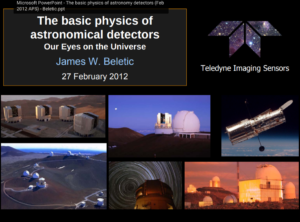
The lead-off speaker, Dr. James Beletic, Director of Astronomy & Civil Space at Teledyne Imaging Sensors (TIS), also chaired the session. He gave a fine overview of optical and infrared detectors and their physics.
The basic physics of astronomical detectors, our eyes on the Universe
Author: James Beletic (Teledyne Imaging Sensors)
The universe is an amazingly huge place. While humankind has directly explored Earth’s sister planets with space probes, we don’t have the means to venture beyond the solar system, and so almost all information about the universe comes from sensing light that happens our way. Astronomy is constantly striving to find better ways to sense the feeble amount of energy from distant stars and galaxies. This quest has led to a new generation of large telescopes on the ground and in space. Possibly more important than the development of bigger telescopes is the rapid advancement in solid state detector technology. In the x-ray, visible and infrared wavelengths, the most advanced detectors are based on two fundamental technologies: (1) nearly perfect detector materials that efficiently convert photon energy to electrical charge, and (2) very sensitive transistors that convert a few electrons into a measurable voltage. This talk presents the basic physics of astronomical detectors and provides an introduction to the more specialized talks that follow in this session of presentations. Since detectors of light are critical to nearly every aspect of scientific research and involve a wide range of physical phenomena, this session of talks will provide the audience with physics lessons that can be readily incorporated in an undergraduate physics curriculum. — SLIDES
